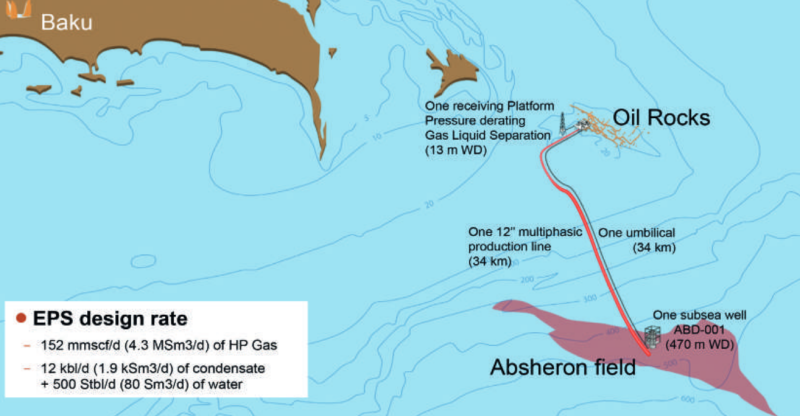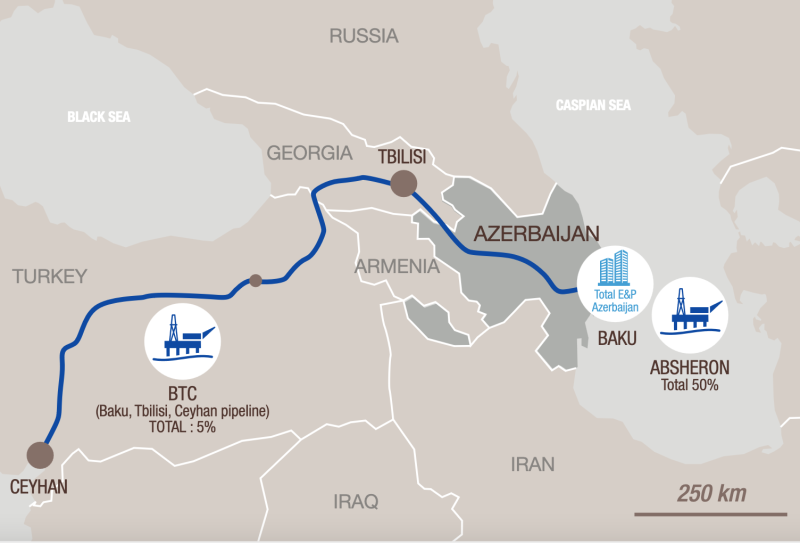TotalEnergies and Azerbaijan’s state oil company SOCAR have initiated production at the Caspian Sea’s Absheron gas and condensate field 100 km southeast of Baku.
Phase 1 of the project connects a subsea production well in 500-km-deep water to a new gas processing platform, that is itself linked to SOCAR’s existing production facilities on the offshore Oil Rocks legacy fields, TotalEnergies said in a 10 July news release.
Absheron’s initial production capacity of 1.46 billion m3 per year (4 million m3/d) of gas and 12,000 B/D of condensate is earmarked for the domestic market, but satisfying the homefront will enable Azerbaijan to raise its overall gas export volumes—particularly to Europe—across its portfolio of upstream projects.
Facilities at Oil Rocks currently supply about 70% of Azerbaijan’s domestic oil and gas demand, according to SOCAR, and to fill the gap, Azerbaijan has had to top off domestic production of gas with imports from Russia and Iran—a necessity, but counterintuitive to Azerbaijan’s quest to join the club of gas exporters offering to help the EU replace Russian imports.
Mission Accomplished: Clearing a Path for Azeri Gas Exports to EU
TotalEnergies is a 50% partner with SOCAR in the Absheron gas and condensate field, operated by the jointly owned Absheron Petroleum company. TotalEnergies also holds a 5% stake in the Baku-Tbilisi-Ceyhan (BTC) pipeline which feeds into Turkey’s Trans-Anatolian Natural Gas Pipeline (TANAP) to Europe.
TANAP joins with the Trans-Adriatic Pipeline (TAP), which in December 2020 delivered Azeri gas for the first time to Europe, a journey that began at the BP-operated deepwater Shah Deniz gas field, traversed Turkey, Greece, Albania, and the Adriatic Sea, and ended at a receiving terminal north of San Foca, Italy. The network of systems is collectively called the Southern Gas Corridor.
In Q1 2023, the Shah Deniz Alpha and Shah Deniz Bravo platforms produced 7 billion std m3 of gas and more than 1 million tons (about 9 million bbl) of condensate, according to BP.
The production capacity of the existing Shah Deniz facility is currently about 74 million std m3/d of gas or approximately 27 billion m3 per year with exports going to buyers in Georgia, Turkey, and Europe, as well as to Azerbaijan’s domestic market.

Azerbaijan’s Absheron field lies 25 km northeast of Shah Deniz and is believed to be capable of producing up to 5 billion m3 per year if TotalEnergies and SOCAR were to invest in a Phase 2 with intent to produce gas for export along the Southern Gas Corridor, according to Eurasianet, an independent news source based at Columbia University’s Harriman Institute.
Azerbaijan, EU Ink MOU To Export Caspian Gas to Europe
Last July, Azerbaijan’s President Ilham Aliyev and European Commission President Ursula von der Leyen signed a memorandum of understanding pledging to deliver at least 20 billion m3 per year of Azeri gas to the EU by 2027, effectively doubling the capacity of the Southern Gas Corridor.
One year later and 2 days after TotalEnergies’ Absheron announcement, Azerbaijan’s Trend News Agency reported that the country had exported 5.7 billion m3 of natural gas to Europe in Q1 2023, quoting a tweet by the country’s energy minister, Parviz Shahbazov, who said exports had risen 7.5% year-on-year in the January–June period.
For the whole of 2022, Azerbaijan had exported 22.3 billion m3 of gas, which represented 47.7% of its total gas production (46.7 billion m3), Shahbazov said in his tweet.
In February 2022, Reuters quoted Saltuk Duzyol, head of the TANAP consortium, as saying that the Turkish component of the Southern Gas Corridor was at that time operating at 100% capacity and had “already reached a plateau in transporting gas for Turkey’s needs (5.7 billion m3 per year)” with another 10.5 billion m3 per year destined for Europe.
Duzyol said plans were in the works for possible Phase 2 and Phase 3 expansions that would increase TANAP’s capacity to 23.7 billion m3 and 31 billion m3, respectively, but construction would take up to 5 years and investment commitments had yet to be agreed.
Among the variables influencing investment decision making are the EU’s desire to remove gas from its energy mix and the question of whether Azerbaijan can produce enough gas to make such expansions commercially viable if the EU wants to buy it.
SOCAR and its partners are already working on the latter point.
Projects in the Pipeline Promise To Provide Whatever Throughput Is Needed
Among other things, BP is studying whether it can tap into gas reserves lying beneath zones currently in production at the Azeri-Chirag-Gunashli (ACG) field block and at the Shah Deniz prospective area.
Eurasianet reported in early July that BP had drilled an appraisal well to a depth of 4500 m below the ACG field and had installed gauges to collect pressure data for analysis.
State news agency AZERTAC quoted Bakhtiyar Aslanbeyli, BP's vice president for communications and external relations for the Caspian region, as saying BP expected to “have a clear view ... by the end of the year” as to whether such reserves, if present, could be produced.
The A22z well was to be drilled from the Chirag platform as a sidetrack from the existing A22 injector well to reach deep gas reservoirs in the south flank location of the structure, according to BP, which is also moving fast to install a new oil production platform on the ACG field.
BP reported in late January that it had spud a new exploration well (SDX-8) in the contract area under the agreement on the exploration, development, and production-sharing on the Shah Deniz prospective area, hoping also to assess deeper horizons beneath currently producing reservoirs.
The Heydar Aliyev semisubmersible drilling rig was moved to the SDX-8 location in the eastern flank of the Shah Deniz field in December 2022 and aims to drill to a depth of around 7000 m, according to BP. Drilling will take approximately a year and will be followed by testing.



